| Home |
| Rarities Committee |
| IL400 Club |
| Checklist |
| Monthly Summaries |
| Birding Reports |
| Rarity Alerts |
| Historical Records |
| Articles |
| Gallery |
| Video Clips |
| Contact Us |
Barak Granit
On July 18th, around 10:00 am, while examining the many terns and some waders resting on the shore in front
of the Pigeon Island off-shore Ma'agan Michael, I noticed two cormorants flying close together.
The cormorants arrived from the south and continued north high over the sea (about 10-15 meters). I looked
through my bins and immediately noticed that one was considerably smaller than the other. I switched to my
scope and watched them all the way until they disappeared far in my north.
The leading cormorant was an
adult Great Cormorant. The second one (apparently a juvenile/immature cormorant) flew behind it and
was considerably smaller in bulk, length and wing span (I would say about 70% of the GC). It had a long
neck and slim head and bill. The tail was relatively short, making the bird to appear like an a-symmetrical
'cross', with head/neck projection longer than tail projection, and clearly different than the symmetrical
'cross' silhouette of a Pygmy Cormorant. The wings were slightly narrower than those of the GC, and
blunt-tipped. Its wing-bits where a bit faster than those of the GC, and the wings raised above the body
level when lifted. The flight action wasn't at all recalling the mechanical and typical flight action of
pygmy Cormorant. The most distinct plumage character I could notice was the pale-buff upper wing coverts
that were in sharp contrast to the dark blackish-brown flight feathers. From below, the entire wing was
blackish and was darker than the blackish upper wing remiges. The chin, throat, breast and belly where
pale buff-off white, the upper head was darker brown. Seeing the bird from behind (while they already past
me) I could notice a darker area in the lower belly/trousers, though it was too late to have good look at it.
All these features matched well a juvenile Shag from the Mediterranean subspecies desmarestii. I
understood that I had just found a 'first' to Israel but somehow was not too excited about it. I knew well
that the chances of relocating vagrant sea-birds, flying along the coast till they disappear, are close to
zero. Beside that, I knew that although I managed to take a lot of features during the short time I had, I
didn't take any photographs, so it wouldn't be enough to establish a solid 'first' record.
Luckily, things turn out to the bright side of life. A day after, Tuvia kahn went
birding at the same place and found the bird perching on a rock near the Pigeon Island, together with the
GC. Knowing that I'd claimed a Shag the day before, he called me immediately and asked me to come and
confirm the identification. I came immediately, and this time got my excitement - the Shag was
there, on its rock, seemed like feeling at home; spending its time fishing and drying in the sun!
By the afternoon, many Israeli birders came to twitch the bird. They did successfully, though it was not
(and still isn't) a difficult task, for while writing these lines, at the end of October 2005, the bird is
still present at Ma'agan Michael.
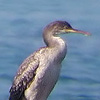 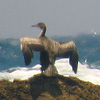  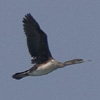 |
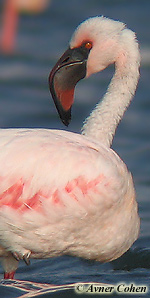 Lesser Flamingo (Phoeniconaias minor) Eilat salt pans, Mar.06 |
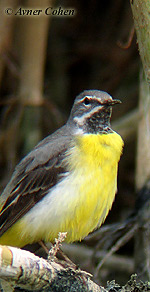 Gray Wagtail (Motacilla cinerea)) Yotvata, May.06 |
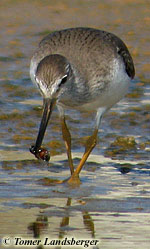 Terek Sandpiper (Xenus cinereus) Ma'agan Michael, Jul.05 |
Back to top